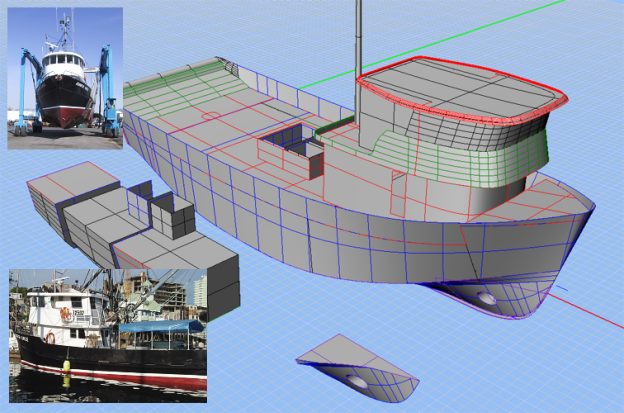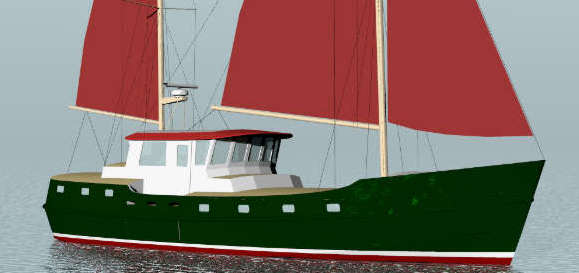Stability Studies
- Stability Studies
- Rig and Spar Design
- Stabilizer Systems
- Powering and Systems
- Structural Modifications
 Consulting takes many forms, it may involve getting my opinion on a particular boat or project or it may include planning or concept sketches and design drawings of a required modification.My work in consulting involves studies of powering, stability, control, motion, construction and arrangements. Small craft are generally anything under about 150' in length. Most of my current work concerns boats 24m and under. I work closely with associated experts including my colleagues in B.C. at CR Engineering.
Consulting takes many forms, it may involve getting my opinion on a particular boat or project or it may include planning or concept sketches and design drawings of a required modification.My work in consulting involves studies of powering, stability, control, motion, construction and arrangements. Small craft are generally anything under about 150' in length. Most of my current work concerns boats 24m and under. I work closely with associated experts including my colleagues in B.C. at CR Engineering. 2016/03/ Current Stability Projects as of March 2016:
- Bellacra Explorer Stability Study
Fast aluminum craft, stability study following successful completion of my recommendations for structural modifications to improve performance
- Majestic Warrior Stability Study Commercial Fish Packer
- Northern Dream Stability Study and Design Modifications for Pilot House 120' Motoryacht
- IV Interceptor Stability Study 36' Commercial Troller
- Leeway Stability Study 40' Schooner
- T1 Stability Study 100' by 25' Landing Craft
- Content Stability Study 60' Motoryacht
-
1. Transport Canada Stability Booklets
Stability Booklets for Commercial Fishing, Small Passenger, Sailing, Sail Training Vessels
We have prepared Transport Canada Stability Booklets for the following vessels: Commercial Fishing, Small Passenger, Sailing, and Sail Training Vessels.
Preparing the Stability Booklet
Every vessel carrying passengers for hire in Canada must meet Transport Canada requirements for Passenger Vessels. Requirements include some form of stability study which may include the preparing of a stability booklet. These vary depending on the vessel size, voyage class, number of passengers carried, and experience of the master and crew. In many cases older vessels are brought into passenger carrying with little or no documentation. I am often requested to facilitate and research these vessels, and prepare the necessary documents. This may involve a simple roll timing experiment, coupled with a 3D computer model to arrive at basic stability characteristics for any vessel. Or it may require extensive measurements of a hull, creation of computer models, and damaged stability studies prior to developing a complete stability booklet as required by TC. Canadian vessels carrying more than 12 passengers will require a damaged stability study and this involves establishing watertight bulkheads to control flooded trim and stability.
Stability Booklet Testimonials
Dear Tad,
Just to say thanks again for your help. Without your expertise and support there is no way we would have got this done so quick. We can recommend anyone who has to get an existing or new vessel through the certification process to secure your services, as they are money well spent and result in big savings and hassles in the long run.
Kind Regards,
Joanne and John Van Strien
Sail Training Vessel, Western GraceTad,
Thanks for your great service on this project. David e-mailed me and the boat perfomed perfectly.
Eric Duncan, Lifetimer Boats
Table Showing Intact Static Stability, Condition No. 2

Stability model for 68' commercial vessel Jennifer GayleLearn More About Our Stability Studies
Case Study for Small Passenger Vessel and Sail Training Vessel Stability Booklets
Case Study for Small Passenger Vessel and Sail Training Vessel Stability Booklets

Close Transport Canada Stability Booklets for the 60' sailing vessel Western Grace to both sail training and small passenger vessel regulations.
Case Study for Small Passenger Vessel and Commercial Fishing Vessel Stability Booklets
Case Study for Small Passenger Vessel and Commercial Fishing Vessel Stability Booklets

Close Transport Canada Stability Booklets for the 68' commercial vessel to both fishing vessel and small passenger vessel regulations.
Case Study for Small Passenger Vessel Stability Booklet
Case Study for Small Passenger Vessel Stability Booklet

Close Transport Canada Stability Booklets for Passenger Vessel Stability, for Lifetimer Boats and the Government of Quebec.
Some Of My Seminars, Blog And Forum Posts On Stability
Vessel Stability: Myths and Reality, All-day Seminar, 2011
Fritzi Ann and the Stability of Fishboats, blog.tadroberts.ca
The Typical Powerboat is Not Seaworthy, blog.tadroberts.ca
On Troller Stability, boatdesign.net
Stability Study for a Bolger Windermere, Stability Study for a Bolger Windermere cont'd and Stability Study for a Bolger Windermere last posts, WoodenBoat Forum:
Right, there is no point worrying about this, the boat is built. But knowledge is power and the more you know about your boat the better your decisions can be......Thus your plans for a rooftop hot-tub may require reconsideration.... This is one of my main points in this exercise, real world is different than theoretical, and it shows the folly of taking seriously stability curves based on published numbers. The good part is that an increase in displacement increases stability....... Stability Study for a Bolger Windermere
-
2. Ocean Racing Stability Letter
Today all vessels entering offshore races are required by ORC (Ocean Racing Club) rules to meet a minimum LPS (Limit of Positive Stability). I’ve done a couple of short studies and created Stability Letters which meet this requirement. This past spring we did an inclining experiment on a Hans Christen 48 to facilitate her entry in the 2012 Vic-Maui Race. The inclining and floatation measurements required several hours work here in Silva Bay. And a 3D computer hull model was created from the original designer’s hull lines drawing (hand drawn by Scott Sprague in 1982) for which no stability data existed.


Stability model for a Hans Christen 48 for an Ocean Racing Stability Letter
-
3. Building to Comply with Transport Canada and ISO Standards
Case Study for TC Approval to ISO 12217-1 and ISO 11812. Canada is in the process of adopting ISO standards for small craft stability, construction, safety, etc.
The Clearwater project involved measuring a hull already under constuction, advising on ISO requirements, creating a 3D hull model, and doing an inclining prior to completing the traditional stability booklet as well as the ISO worksheets required to certify the vessel to carry 10 passengers.
Case Study for New Boat Concerns: Building to Comply with Transport Canada and ISO Standards for Small Passenger Vessels
I was recently asked to look at a new Small Passenger Vessel project by a local builder. The owner intends to operate a 26' fast aluminum vessel in the Gulf of Georgia carrying 10 passengers on day trips. As the builder has not previously built a Transport Canada certified Small Passenger vessel, he had a number of questions regarding the adaptation of his stock pleasure model for this use. The owner also has a number of concerns regarding area of operation and propulsion options. Both the builder and the owner want the vessel to comply with incoming TC (2006) ISO standards for stability and deck drainage.
The good news is that in my opinion complying with the regulations and standards is not difficult, if it is taken into consideration early on. In this case we are several months from start of construction. Open and cooperative discussion with Transport Canada is a major asset in this undertaking.
The first requirement from Transport Canada is proper CAD 'as built' drawings of the vessel. Sketches on the back of an envelope will not do it. This is so the Transport Canada inspectors can satisfy themselves that the boat is designed, built, arranged, and equipped in a seamanlike way suitable for the intended service.
The second major requirement is complete vessel hydrostatics written up in the form of a Stability Booklet. To create this the vessel must be launched and an inclining test (witnessed by TC) done to establish GM. This experiment coupled with the hydrostatic information from a 3D computer model allows the Naval Architect to determine KG, the vertical center of gravity of this particular vessel. Using the above information, stability calculations for all conceivable loading conditions can be calculated. This is important as the TC and ISO standards stipulate a stability requirement for each operating area.
- TC concerns regarding the actual layout and construction of the boat include the following areas:
- - Fuel Shutoff is to be directly inside the engine room and remotely accessed
- - Fuel Tank Cleanout access to the fuel tank for inspection and cleaning
- - Water tight Engine Room hatch
- - High engine air vents
- - Closures for those vents
- - Positive engine room hatch dogs
- - Positive cockpit side door dogs
- - Solid gate on transom door
- - Door sill height
If taken into account at an early stage, these features add very little to cost or construction effort.
The owner of this vessel was concerned about his options as to operating areas because TC certifies a Passenger Vessel for a particular use with a particular Master. I was able to assure the owner that the boat will not require any changes to operate within Home Trade III classification anywhere on the BC coast.
Finally, we entered into a study of propulsion options. Though an engine has been chosen, the particular gearing ratio and outdrive vs. surface drive questions require some study. The outdrive option is proven and common in this application, the surface drive holds some promise of increased propulsive efficiency due to lower drag and larger diameter propeller. The surface drive is also simpler mechanically and slightly less vulnerable in high-speed collision. But there are risks involved when utilizing technology that is somewhat new. Reliability and possible downtime are major concerns that must be answered in a sound way for a single engine vessel. Access to dealer assistance and parts are also factors in the implementation of any system on a commercial vessel.
- TC concerns regarding the actual layout and construction of the boat include the following areas:

